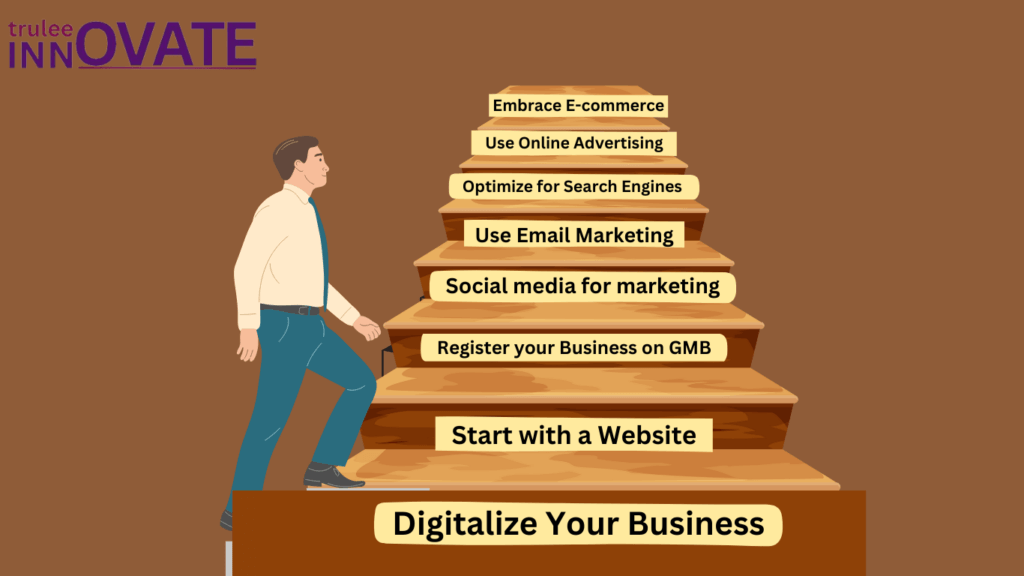In today’s fast-paced digital world, staying offline is no longer an option for small businesses. Your potential customers are searching for products and services online, comparing options, and making decisions based on the information they find. If your business isn’t part of the digital conversation, you’re likely missing out on valuable opportunities.
Digital transformation for small businesses might sound intimidating, especially for owners juggling multiple responsibilities. But don’t worry—taking your business online is not only achievable but can also be highly rewarding. In this guide, we’ll walk you through the essentials of digitalizing your business, making it easy to understand and implement. By the end, you’ll see how going digital can help you connect with customers, boost your brand awareness, and ultimately grow your business.
Let’s get started!
Why Digital Transformation for Small Businesses is Needed:
1. Meet Your Customers Where They Are
Social media, Google, reviews literally everything is where your customers are. Without an online presence your business conversation goes off completely.
- Build Credibility and Trust
Social platforms and websites that are credible and appealing show more advertising over professionalism. Businesses with a strong online credibility are preferred over those that do not exist and are less likely to have a business in the online realm.
- Expand Your Reach
No more limitations to just marketing strategies using small businesses with marketing for websites. Building through social media adverts, email campaigns or any other SEO related strategy boosts audience reach.
- Stay Competitive
Your competitors are probably already established in the digital era and strive to stand out and keep their place. For this reason, embracing new technology is necessary.
- Save Time and Resources
Email automation, online payments, and inventory management are just a few of the digital tools that can simplify procedures and help you save time and money.
Steps to Digitalize Your Business
1. Start with a Website
As a product seller, a potential customer sees a representation of you through your functional website. This website helps these potential clients to understand your products, services, and even your business’s core ideals. These clients need certain elements in that website that a seller has to consider.
Domain Name: This has to be selected in a way that it is simple and easy to remember, reflecting what the brand stands for.
Professional designing: the user interface of the website has to be appealing and easy to navigate. The website also has to be usable across different devices.
Loading in: A contact page, an “About” section, a Services/Products page, a blog, and a homepage would need to be included in the website as mandatory pages.
Call to action page: A potential client should have an easy access to what to do next, whether that be filling up a form or proceeding with the purchase of a product.
2. Register your Business on GMB
Google offers a free service called Google My business which helps in the management of one’s business profile on apps such as Google Maps and Google search. Here are some steps to get started:
Creating a business profile: Joining GMB involves this step.
Adding Address and website links: An important step that has to be undertaken by an individual is include their details such as address, number and their working hours.
Being Review Encouraging: Customers have to be encouraged in leaving reviews.
3. Social media for marketing
Being cost-effective, social media acts as an advertising tool or marketing tool for many in building awareness of their brand and interacting with the audience. Here are some suggestions for doing this:
- Focusing on the Correct Platforms: Be it Instagram or Facebook, it is best to focus on the applications your target audience is on.
- Post regularly: Customer stories, tips, or even behind the scenes can be shared by engaging material to be regularly posted.
- Run Ads: Social media ads can help you target specific demographics and drive traffic to your website.
4. Use Email Marketing
Email marketing is one of the best methods to keep in touch with your clientele. Here’s what to do to do it right:
Create an email list by providing a freebie such as a guide or a discount.
Regularly notify your clients of new products, services and promotions.
Narrow down your emails to your audience.
5.Optimize for Search Engines (SEO)
SEO of a small company allows your site to be highly visible thus making it easy for potential clients to reach you. Aim at:
- Inserting important key phrases such as “business digitalization for small businesses”.
- Developing great content.
- Optimizing the speed of the site.
- Getting backlinks from other respected sites.
6.Use Online Advertising
PPC (Pay-per-click) adverts on Google and Facebook can bring immediate traffic to your site. Some important pointers:
- Set limits on your spending.
- Seek particular audiences.
- No stopping, check and enhance your campaigns.
7.Embrace E-commerce
If you’re a product seller, you can always extend to have an online shop on your website. An e-commerce store is easy to set up with services such as Shopify and WooCommerce.

Challenges of Digital Transformation for Small Businesses :
- Financial Restrictions
The thought of going digital and investing in technology weighs heavily on the minds of many small businesses. Start by investing in inexpensive tools such as a google my business profile and a basic website and then invest further in marketing tools once the company starts expanding.
- Shortage of Technical Professionals
If you don’t have strong programming skills, the world of digital tools can seem complicated. Seek the help of freelancers or agencies with resources such as website designers, SEO and ad specialists.
- Low amount of Time Available
Most small business owners have various roles, therefore setting aside a few hours at the beginning of every week to focus on the digital aspect of the business is highly recommended, Alternatively, you can assign the task to another trustworthy team member.
Success Stories: Small Businesses That Thrived Online
Case Study 1: A Local Bakery
By creating an Instagram account and posting daily updates, a local bakery grew its customer base by 40% in six months. Their secret? Engaging visuals and timely responses to comments and messages.
Case Study 2: A Home Cleaning Service
This business used Google Ads to target homeowners in their city. Within three months, they doubled their client bookings and gained a steady stream of leads.
Call-to-Action: Let’s Get Started!
Ready to take your business online and unlock its full potential? Our team at truleeinnovate specializes in helping Digital Transformation for Small Businesses like yours succeed in the digital world.
- Call us today to discuss your needs.
- Visit our website at www.truleeinnovate.com to learn more about our services.
Don’t wait to make the leap. The digital world is waiting for your business to shine—and we’re here to guide you every step of the way.


